 I’ve been told that my Hummels were “for the birds” but this was not the way I took their criticism. They were right in that there are at least 96 different figurines (and counting) featuring in some way, a bird. Little did they realize how many Hummel figurines indeed have birds perched somewhere as part of one of these figurines. A quote taken from the book Hummel art II says, “… the little bird which has become almost as much of an M.I. Hummel symbol as the small button-type flowers used in so many designs.” The numerous M.I. Hummel plates have not been included on this page. This list begins with the lower number HUMs and increases as you scroll down. This also, in some ways, is an historical chronology of the items as they were created one after another. Enjoy.
I’ve been told that my Hummels were “for the birds” but this was not the way I took their criticism. They were right in that there are at least 96 different figurines (and counting) featuring in some way, a bird. Little did they realize how many Hummel figurines indeed have birds perched somewhere as part of one of these figurines. A quote taken from the book Hummel art II says, “… the little bird which has become almost as much of an M.I. Hummel symbol as the small button-type flowers used in so many designs.” The numerous M.I. Hummel plates have not been included on this page. This list begins with the lower number HUMs and increases as you scroll down. This also, in some ways, is an historical chronology of the items as they were created one after another. Enjoy.
This page was updated on 14 June 2022.
Hummels with Birds
You will find a great variety of figurines in this category due to the tremendous popularity of the birds. This list is for the M.I. Hummel figurines and does not include those bearing the Berta Hummel mark.
HUM 10 – Flower Madonna
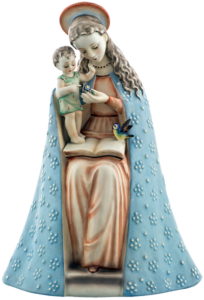
Height – 10 – 8 inches
Height – 10/I – 8¼ inches (color)
Height – 10/I – 8¼ inches (white)
Height – 10/III – 11½ inches (color)
Height – 10/III – 11½ inches (white)
According to factory records, this popular religious figure was adapted by Goebel’s master sculptor Reinhold Unger about 1935. In 1956, the mold was renewed by Theo R. Menzenbach and made approximately 2 inches smaller. The halo was changed at that time from the open style to the flat style. The earliest catalogs list the two sizes at approximately 8 inches and 11 inches, although other size molds must have been used because of the wide range of sizes found. It has also been located in more color combinations and modifications of design than probably any other motif. The other known colors are an antiqued caramel color, an aqua with a burnished gold leaf halo, a pastel blue, a reddish brown, and a creamy ivory. There may be more out there since two of these discoveries were found within the past few years. Until about 1955, the halo was open in the back and is referred to as the “doughnut halo.” The redesigned piece was introduced with a solid halo that has no opening in the back. Colors, except the current lavender blue and glazed white, are considered rare, with prices in the low to mid four-digit figures. Examples have also been found marked 10 (only) and 10/3 (Arabic). The older color variations will usually range from $2,500 to $3,500 depending on the color, condition and other variations. Old catalogs list it as large as 14 inches. Also called “Sitting Madonna and Child” or “Virgin With Flowers” in some of the older catalogs. You may also find it incised as 10/3 instead of 10/III.
HUM 22 – Holy Water Font, Angel With Bird

Height – 3 1/8 to 4 7/8 inches
This was first figurine modeled by master sculptor Reinhold Unger in 1935 with the old name of “Sitting Angel.” The title of this font has been expanded to accommodate both the original German name, Weihbesael, situnder Engel and the name in the U.S. catalogs which refers to it as “Angel with Birds” because many fonts appear with only minor design modifications of small children or angels, some with wings and some without. Listed in the 1950 catalog in the two sizes, the larger size apparently was dropped from the line sometime after that. There are variations in size, color and design of the bowl. The small size sold in 1955 for $1.35 according to that price list. The 1997 price list shows this item with the name as “Angel Sitting.”
HUM 33 – Joyful, Ashtray
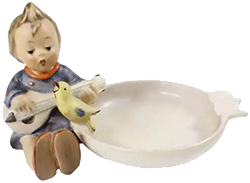
Height – 3¾ inches
The numbering sequence indicates that this figure was used for the first ashtray introduced by Goebel in this line. In addition, this figure was used on the ashtray before it became the separate figure Joyful, Hum. 53, or the Candy Box, Hum. III/53. It was also used in the designs of two model numbers for which there is no record of production, Bookends, Hum. 120, and another design of Ashtray, Hum. 216. Some sources have indicated that this is a likely subject for the Annual Bell. Designed and issued before 1950, it is found in all trademarks with minor variations. The German name is Ascher, Gesangsprobe, or “Ashtray, Singing Rehearsal.” Another reported name is “Boy with Mandolin and Bird.” The original drawing for all of these related issues is owned by Verlag Ars Sacra. It is available in postcards as #14284.
HUM 34 – Singing Lesson, Ashtray
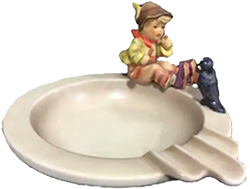
Height – 3½ inches
This example was the second ashtray in the line and also produced before its companion figurine, HUM 63 Singing Lesson. Both pieces were made before World War II. HUM 34 is found in all trademarks with little variation in size, design, or coloring. A 1950 U.S. catalog refers to this piece as “Ashtray, Boy with Raven” which highlights the difference between the ashtray and the figurine, HUM 63, the candy box HUM III/63, and the bas-relief of this motif used on the 1979 Annual Plate HUM 272. The ashtray is the only adaptation of this motif that shows a raven. All the others use a differently shaped yellow bird. When Sister Hummel made her original drawing, which is now owned by Ars Sacra, it was done with a yellow bird up in a tree as depicted on the 1979 Plate. Some minor variations may be encountered in comparing examples of different ages. The German name is Ash, ‘s stimmt net, or “It’s Not Right.” The original drawing was reproduced by Verlag Ars Sacra as postcard #14701.
HUM 47 – Goose Girl

Height – 47/3/0 – 4 inches
Height – 47/0 – 4¾ inches
Height – 47 – 5½ inches
Height – 47/II(2) – 7½ inches
The 5½ inch size of this popular motif was listed as 47 (only) in the 1947 catalog and priced at $7.50 less than one-tenth of today’s price. This model has been widely reproduced by various makers in the U.S. and Asia but WITHOUT the M.I. Hummel facsimile signature and not only in porcelain but also in glass. It appears as the motif on the 1974 plate and as one of the pair of bookends, HUM 60 B. Some of the earlier issues were made with a projection between the two geese painted green and referred to by collectors as a “blade of grass.” 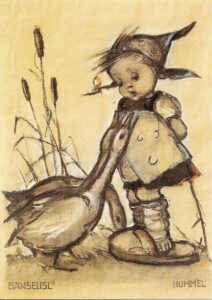 This commands a premium of 50 percent over the value in the Price List. Two extremely rare, perfect versions of Goose Girl in Serbian costume from the International Figurine Series with 947/0 incised on the bottom are known. One was in the collection of Robert L. Miller and the other is owned by an original owner. Other examples of this design are the lithographs from Sister Hummel’s original drawing produced as postcard #220 by Verlag Emil Fink.
This commands a premium of 50 percent over the value in the Price List. Two extremely rare, perfect versions of Goose Girl in Serbian costume from the International Figurine Series with 947/0 incised on the bottom are known. One was in the collection of Robert L. Miller and the other is owned by an original owner. Other examples of this design are the lithographs from Sister Hummel’s original drawing produced as postcard #220 by Verlag Emil Fink.
HUM 57 – Chick Girl
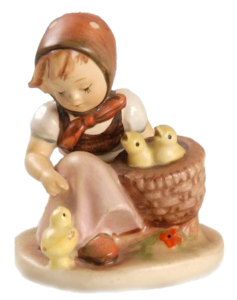
Height – 57/0 – 3½ inches
Height – 57(.) – 4¼ inches
Height – 57/I – 4¼ inches
This model, introduced in the 1930s and originally marked only 57 or 57. (decimal), was listed as 4 inches high in the 1947 catalog. Later, this designation was changed to 57/0 in a 1950 catalog for the 3¼ inch size and at the same time, the larger size 57/I was listed at 4¼ inches. This larger size has three chicks in the basket instead of two as in the small first version. Presently, 57/0 and 57/I are listed as3½ inches and 4¼ inches respectively. An example of 57/0 has been verified without a chick near the girl’s right foot and valued at a mid three-digit figure. This design is also used for the candy box, III/57 following, and as one of the pair of bookends, 61 B. It appears as the motif on the 1985 plate. “Little Chick Girl” was an earlier name, as was “Little Chick Mother,” the translation of its German name, Kükenmuttershen. The original drawing is owned by Verlag Ars Sacra, and postcard #4951 has been published by them from the original.
III/HUM 57 – Chick Girl – Candy Box
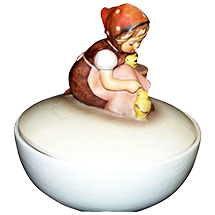
Height – III/57 – 6¼ inches
The bowl style was first produced in 1936 while the jar style was first produced and sold in 1964. It is sometimes found with the incised number III 57/0 on the bowl style pieces. The model number is found on the underside of the lid while the “M.I. Hummel” signature is located on the topside of the lid directly behind the figure. Chick Girl candy box was “temporarily withdrawn” (TW) from production on 31 December 1989. Overall size of this figure and box is 5¼ inches or 6¼ inches depending upon the source of information. Differences probably due to a design change in the type of bowl and the lid used. Newer lids also show green grass painted around the figures while the older models do not show this.
IV/HUM 57 – Chick Girl – Music Box
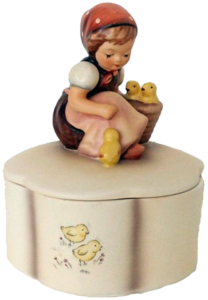
Height – IV/57 – 6 inches
Limited Edition to 29,900 copies
In 1996, a new music box was produced with model number HUM IV/57 applied by decal on the bottom with TMK-7. This is one of four in a series of music boxes produced for the European market only as of this date. The other three were HUM IV/53 Joyful, HUM IV/58 Playmates, and HUM IV/63 Singing Lesson. This item borrows the figurine HUM 57 Chick Girl to be placed on the lid and has a colorful reflection of two small chicks running through the grass. Notice that the designation has a prefix of the Roman numeral IV to represent this is a music box. The bottom part, the music box, was manufactured by Ardleigh & Elliott. On the bottom is some information which translates from German as follows: Limited edition: 29,900 copies, “Chick mother”. This music box is an authentic M.I. Hummel product, created by the artistic team of the W. Goebel porcelain factory according to the drawn originals of the Franciscan M.I. Bumblebee. Editing by Ardleigh Elliott. Objekt-Nr .: 73054. Melody: “Rejoice in Life”. The actual German is: Limitierte Auflage: 29,900 Exemplare, “Kükenmütterchen”. Diese Musikdose ist ein authentisches M.I. Hummel-Produkt, geschaffen vom Kunstlerteam der W. Goebel Porzellanfabrik nach den gezeichneten Vorlagen der Franziskanerin M.I. Hummel. Herausgeeben von Ardleigh Elliott. Objekt-Nr.: 73054. Melodie: “Freut euch des Lebens”. Trademarked Goebel, Germany 1996.
HUM 60 B – Goose Girl, Bookend
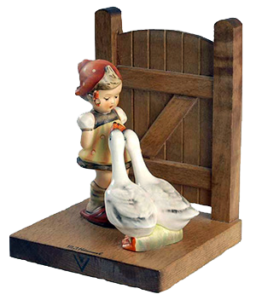
Height – 4¼ inches
This Bavarian country child was first produced in September 1936 and was coupled as bookends and sold only as a pair. These early design bookends have the figures mounted directly onto the wooden base, whereas the later ones, such as Apple Tree Boy and Apple Tree Girl, 252 A and 252 B, have the figurines on the normal integral ceramic base which is mounted and glued to the wooden bookends. For this reason, the trademark is on the wooden base itself, rather than on the figurine. The TMK-1 Crown trademark is considered rare. An early 1950s catalog indicates these were listed as only HUM 60 at 6” high compared to the present 4¾“. The mold number has also been observed on the back of the slippers on other early pieces. The bookends have been temporarily withdrawn from production status effective December 31, 1984.
HUM 61 B – Chick Girl, Bookend
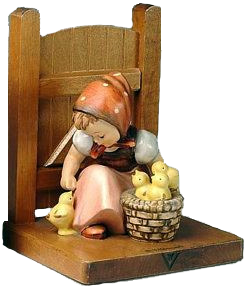
Height – 4 inches
These were first produced in November 1936. Reference may be made to figurine HUM 57 for more details on this one. Very much like the preceding pair of HUM 60 bookends, these figures were also mounted directly on the wooden bases rather than the composite figurine and base mounted on the wooden platforms as in the larger designs. Again, these are trademarked on the back of the wooden base as were HUM 60 A&B. In the 1950 catalog, these also were listed as only HUM 61 and therefore, might be found marked that way. By 1965, the catalogs listed them with separate alphabetical letters. The TMK-1 Crown trademark is considered rare. They were originally listed at 6” high instead of 4” which is now the current size. The bookends were temporarily withdrawn from production status effective December 31, 1984.
HUM 62 – Happy Pastime, Ashtray
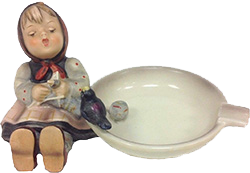
Height – 3½ inches
This is a case where the motif was probably first used on a functional piece before it was introduced as the separate figurine, Happy Pastime, HUM 69. Sister Hummel’s original drawing shows the bird in an adjacent tree, somewhat as it is positioned in the 1978 Annual Plate which has the same motif in bas-relief form. An early catalog shows this piece as being only 8 cm high as compared to 9 cm or 3½ inches high at present. It was first called “Ashtray with Knitter,” with other names as “Little Knitter,” and “Knitting Liesl,” with the translation of the German name Stickliesl. It is reported that one of the early marks, a Crown TMK-1, had the incised facsimile signature on the back of the tray. The current models have the signature on the back of the figure. Such deviations and small changes that may have occurred in design are allowed for in the Goebel Price List. However, there is always the possibility of something not yet recorded. The figurine itself, HUM 69, has been used for illustration for the month of December in the 1969 calendar.
HUM 63 – Singing Lesson
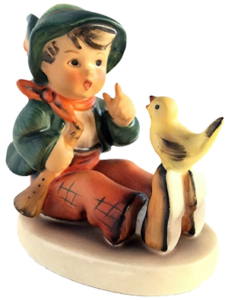
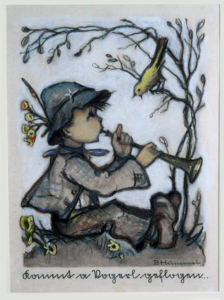 Height – 2¼ inches
Height – 2¼ inches
Some of the compromises that had to be made in adapting Sister Hummel’s originals into three-dimensional figures can be seen when comparing the original drawing to the figurine here. The bird had to be placed on the boy’s toe rather than in a tree. Note that the birds on the plate, figurine, and candy box represent one species, while the bird on the ashtray HUM 34 is quite different and was referred to as a raven in the early catalog. This introduction in the 1930s was listed in the 1950 catalog as “Duet.” It has been made with variations in size and also in the assembly of the components. Minor differences such as these, if significant, are allowed for in the Price List. Frequently, this piece commands a premium at auctions and sales because it is often paired with the 1979 annual Plate, Hum 272 for display in shadow boxes. The original drawing is owned by Verlag Ars Sacra creating the postcard #4949.
The illustration shown here is from the original sketch by Sister M.I. Hummel from the Donald Deeks Collection held at auction on Saturday, 16 January 2021 in Clearwater, Florida.
HUM III/63 – Singing Lesson, Candy Box
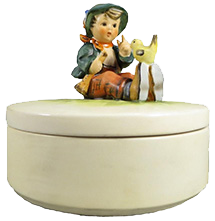
Height – 6 inches
When the model number is preceded by the Roman numeral III as in the case of this item with HUM III/63, this is an indication that the article is a candy box. As with the other candy boxes, the shape, when first introduced in the 1930s, was more spherical, with the design being changed later in the early 1960s to a straight-edged version. The positioning of the arms and head may vary in the assembly.
HUM 69 – Happy Pastime
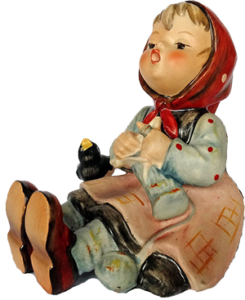
Height – 3½ inches The original drawing by Sister Hummel shows the bird in a tree instead of being placed at the busy knitter as shown here. This was due to the complexity of the figurine being a three-dimensional figure. Because of the correlation with the 1978 plate, the figurine sells at a premium price in the secondary market. Although 69.(decimal) has been reported in the Full Bee TMK-3and the TMK-5 trademarks, the figurine was only issued in this one designation and with minor size variations. The only major change is in the name, from “Knitter” to “Happy Pastime,” sometime after 1950. No major variations in design or coloring have been reported to date. This motif was also used on the Ashtray, HUM 62 and the Candy Box, HUM III/69. An illustration of the figure in color appears for December in the 1969 calendar. The original drawing is owned by Verlag Ars Sacra, and graphics from it are available from them as the postcard #4948.
The original drawing by Sister Hummel shows the bird in a tree instead of being placed at the busy knitter as shown here. This was due to the complexity of the figurine being a three-dimensional figure. Because of the correlation with the 1978 plate, the figurine sells at a premium price in the secondary market. Although 69.(decimal) has been reported in the Full Bee TMK-3and the TMK-5 trademarks, the figurine was only issued in this one designation and with minor size variations. The only major change is in the name, from “Knitter” to “Happy Pastime,” sometime after 1950. No major variations in design or coloring have been reported to date. This motif was also used on the Ashtray, HUM 62 and the Candy Box, HUM III/69. An illustration of the figure in color appears for December in the 1969 calendar. The original drawing is owned by Verlag Ars Sacra, and graphics from it are available from them as the postcard #4948.
The illustration shown here is from the original sketch by Sister M.I. Hummel from the Donald Deeks Collection held at auction on Saturday, 16 January 2021 in Clearwater, Florida.
HUM III/69 – Happy Pastime, Candy Box
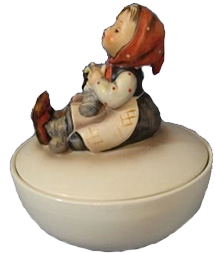
Height – 6½ inches
The bowl style was first produced in 1937 while the jar style was first produced and sold in 1964. The model number is found on the underside of the lid while the “M.I. Hummel” signature is located on the topside of the lid directly behind the figure. The Happy Pastime candy box was “temporarily withdrawn” (TW) from production on 31 December 1989. One interesting variation of this candy box, found with a pastel green rim on both the bottom and the top of the old-style box, commands a 25% premium over the plainer version. The original drawing was the same one that was used for the 1978 Annual Plate, HUM 271 and the figurine HUM 69.
HUM 90 B – Adoration without Shrine, Bookend

Height – 4¾ inches
Cancelled Number (CN)
Research by Robert Miller and the Goebel factory has established that this number was assigned to a pair of bookends using the figurine Adoration, HUM 23 without the shrine, for design and prototypes for possible production. The figurine was mounted directly on the wooden base as were other early models. According to the factory records, all work was discontinued in February of 1939 and only a factory sample is currently known. There is no record of this number found in the U.S. Copyright Office. Any prototype or early model would be marked with a Crown TMK-1 trademark. The original drawing is owned by Verlag Emil Fink and published as a postcard #839 with prints also as #100A and #100G.
HUM 105 – Adoration With Bird
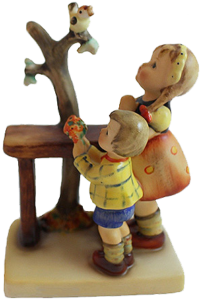
Height – 4¾ inches
Closed Edition (CE)
The first examples of this figurine, which has also been referred to as Bird Lovers, were only recently found and are considered extremely rare. Further research of the factory records indicates that this piece was classified as a Closed Edition on 24 May 1938. All of the known examples bear the double Crown (incised and stamped) TMK-2 trademark. There are notable differences in the pigtail of the little girl. The shrine that the children gaze at is replaced by a tree trunk with a bird holding the attention of the children. A slightly different version, closed out in the same year, was used in HUM 90 B, one pair of a set of bookends. There is no original drawing in this form done by Sister Hummel to be located as of yet. We do not know when the model was originally created or who the original sculptor was for this figurine but most likely was the master sculptor Reinhold Unger who also created the model for HUM 23 Adoration which is very similar in design. This figurine is considered extremely rare and would be valued in the mid four-digit range.
HUM 110 – Let’s Sing
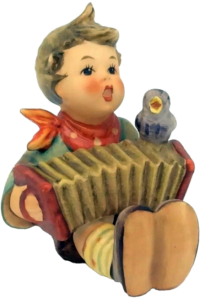
Height – 110/0 – 3 inches
Height – 110/I – 4 inches
Since this motif was used in bas-relief form on the First Annual Bell in 1978 as HUM 700. The price of this figurine in the secondary market has advanced disproportionately compared to similar figurines at times twice as much. The piece has also been found as 110. (decimal) with a Crown TMK-1 trademark being 4 inches high and with 110 (only) with a Full Bee TMK-2 trademark. One variation has been reported as having the feet apart. No other names have been found except the German, Heini, Bandonconspieler, for “Heini, the Accordion Player.” This design was registered as G33487 on March 31, 1939 and again on February 23, 1967. This motif is also found as the Candy Box HUM III/110, the Ashtray HUM 114 and as a Closed Edition of Bookends, HUM 120 B copyrighted before 1940. A picture of this figure appeared on the July calendar for 1974. Verlag Emil Fink owns the original and has produced an exact likeness as the postcard #816. Verlag Ars Sacra owns a very similar original, and postcard #14406 produced from that version.
HUM III/110 – Let’s Sing, Candy Box
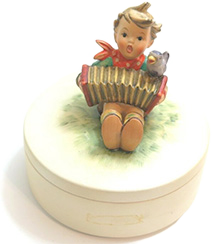
Height – 6 inches
The Roman numeral III is used as a prefix to the model number to indicate that this article is a candy box as in HUM III/110. When first introduced before World War II, the shape of the base was spherical like a deep soup or cereal bowl and the cover, which fitted inside, had a slight crown. This was redesigned in the 1960s so that the box now has straight sides and the cover laps over an internal lip and is flush with the sides. The diameter of the new design, while cataloged as being the same as the old style, is somewhat smaller.
HUM 114 – Let’s Sing, Ashtray
Height – 3½ inches

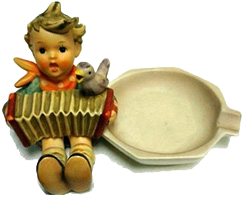
This piece is an ashtray with a figure very much like HUM 110 Lets’ Sing positioned at the edge of the dish. It is found with the figure on either the right or the left side of the tray. Both styles can be found with the TMK-2 Full Bee trademark. The older ones have the figure on the right side. First modeled in 1938 by master sculptor Reinhold Unger. It was restyled in 1959 by master sculptor Theo R. Menzenbach with the ashtray on the right. Its popularity has jumped since the motif was used on the First Annual Bell, HUM 700 in 1978. When found with the ashtray on the boy’s right (viewer’s left) and Crown mark, the value is estimated to be in the high hundreds. The ones with the current marks have the tray on the boy’s left (viewer’s right). One interesting example has been found in the new style (ashtray on the boy’s left) but with the TMK-2 trademark. This model has been in the line since the late 1930s.
HUM 120 – Joyful/Let’s Sing, Bookends
Height – ? inches
The Goebel Company records this as an edition that was closed in the late Thirties and states that there is no known example at the time this book was prepared, not even a factory sample. Any collector who is fortunate to own such a piece, and it is possible, should consider the value as being in the high four-digit figures. See Joyful, Hum. 53, and Let’s Sing, Hum. 110, for more information and related originals and graphics.
HUM 121 A – Wayside Harmony
HUM 121 B – Just Resting
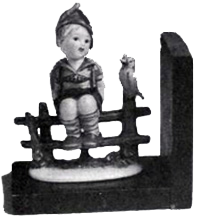 Closed Edition (CE)
Closed Edition (CE)
This pair was listed as a Closed Edition by the factory in the late Thirties, only this sample is known. These, as HUM 120 and HUM 122 are designed by placing the figures directly on the wooden base which carry the number and trademark. They represent another challenge to the well-informed and sharp-eyed collector to be the first to acquire such a set which would be valued in the high four-digit figures. It is likely that they would be glued directly on the wooden base similar to Doll Mother, HUM 76 A. There are no known examples currently in any private collections. Listed as a closed edition on factory records 16 June 1939 made by a combination of sculptors. This bookend half was located in central Europe and is now part of the Robert L. Miller collection.
HUM 141 – Apple Tree Girl
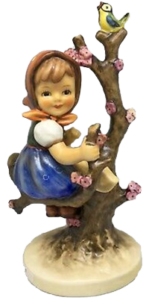
141/3/0 – 4 to 4¼ inches
141/0 – 5 inches
141 – 6 to 6¾ inches – Closed Edition
141/1 – 6 to 6¾ inches
141/V – 10¼ inches
141/X – 32 inches – Temporarily withdrawn
This figurine and its companion, Apple Tree Boy HUM 142 (below) have been favorites with collectors since the 1940s. The present English name and the name “Spring,” a foreshortening of the German name, Frühling, Mädchen im Baum, were used in various early catalogs. This was first issued in the 6 inch to 6¾ inch size and marked 141 (only) or 141. (decimal). The figurine was shortly thereafter issued as 141/I and 141/3/0 have been found in the Crown TMK-1 trademark. In both of the early sizes, the base and tree trunk appeared as one. These two sizes differed with the smaller 141/3/0 size being the only one issued without a bird in the top of the tree. One interesting piece, marked 141 (only) was discovered in white overglaze being the only one found to date. The next recorded size, the 141/V was introduced around 1970 and is found only with the trademarks beginning with TMK-4. This was modeled by master sculptor Skrobek who also restyled the other sizes. The giant size 141/X at around 32 inches was first available in the U.S. in 1976 in very limited quantities and priced at that time for over $6,000.
HUM 142 – Apple Tree Boy
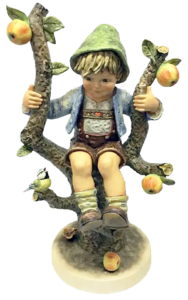
142/3/0 – 4 inches
141/0 – 5 inches
142 – 6 inches – Closed Edition
142/1 – 6 inches
142/V – 10¼ inches
142/X – 32 inches – Temporarily withdrawn
The history of this companion piece is essentially the same as the Apple Tree Girl described above. One difference is the time of year indicated by the ripe fruit on the tree giving it the name of “Fall,” as the German name, Herbst, Junge im Baum implies. Verlag Ars Sacra produces graphics of this pair from their originals as #5723 and #5724. These figurines appear in calendars for September 1962, September 1967 and May and October 1974. The motifs are also used for the 1975 and 1976 Annual Plates HUM 269 and 270; Lamps HUM 229 and 230; and Bookends HUM 252 A&B.
HUM 165 – Swaying Lullaby, Plaque
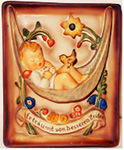
Height – 5¼ inches
Originally modeled by master sculptor Arthur Möller in 1946. Not pictured in very many catalogs; most collectors were not aware of the existence of this plaque until the early 1970’s. For some years, this was a very high-priced collectible when found with a Crown TMK-1 or a Full Bee TMK-2 trademark. They could be obtained only in the secondary market. The first purchase came through an American soldier who had been stationed in Panama. Put back into current production in 1978 for $35 U.S. and is now available in TM-5 and TM-6. Older models have the “M.I. Hummel” signature on the back while newer models have signature on the front lower right corner. The old name in German was Kind mit Hangematte “Child in a Hammock.” The inscription reads: “Dreaming of better times.” This piece is considered rare in Crown TMK-1, Full Bee TMK-2, and Stylized TMK-3 trademarks. It was restyled in 1979. Current production models are slightly thicker in depth, with the M.I. Hummel signature on the back. “Swaying Lullaby” wall plaque was “temporarily withdrawn” (TW) from production on 31 December 1989.
HUM 166 – Boy With Bird, Ashtray
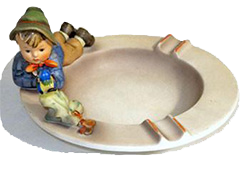
Height – 6¼ inches
This ashtray was modeled by master sculptor Arthur Möeller in 1946. Only slight variations exist in color and construction through the years and there are no major differences between the old and new models. While this has been found in all trademarks, it was not always cataloged, possibly due to low demand. The boy lying prone differs from HUM 34, Singing Lesson Ashtray, in which the boy is seated as in the figurine HUM 63, the HUM III/63 candy box, and the HUM 272 1979 Annual Bell. The bird also varies in design and color. This item was “temporarily withdrawn” (TW) from production on 31 December 1989. The German phrase Junge mit Vogel translates to “Boy with Bird.” The original drawing is owned by Ars Sacra who has published a reproduction of the drawing as a postcard #5862.
HUM 167 – Angel with Yellow Bird
Holy Water Font
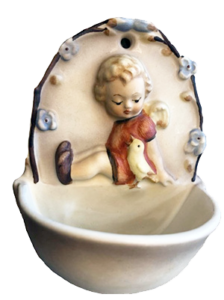
Height – 4¼ inches
This name has been modified since the font, Angel with Birds HUM 22, also has a seated angel with birds. In this case, the angel is facing to the left with no halo. In HUM 22, the angel is facing to the right and has a halo. The early Full Bee TMK-2 model of HUM 167 does not have the hanging hole in the top of the font and the edge of the bowl is stippled with no extension or protruding flange at the back of the bowl. At that time, the width was only about 2 inches. As with other fonts, this has not been continuously cataloged although it has been produced with all of the trademarks.
HUM 169 – Bird Duet
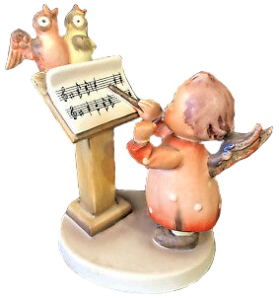
Height – 4 inches
Orignally modeled in 1945 by master sculptor Arthur Möeller; later restyled in 1967 by master sculptor Gerhard Skrobek. Since being introduced around 1950, the birds have changed their tune at least three, possibly more times based on the music that appears on the stand. This is only one of innumerable modifications in design, color, and height, some of which were due to general restyling about 1961 such as the angel’s wings, gown and position of the baton. Other changes noted are the color variation of the birds, angel’s hair and gown as well as the music stand. With the Full Bee TMK-2 trademark (early 1950s) the black baton was raised, as compared to the red baton at rest in the TMK-6 version. Bird Duet was part of the “Personal Touch Personalization” program and could be personalized with a name or date by a Goebel artist for a $20 fee. In the German catalog, the spelling was once Duett. The German name deviates from this theme by calling it Frühlingslied, for “Song of Spring.”
HUM 172 – Festival Harmony (Mandolin)
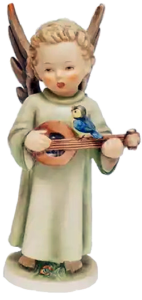
Height – 172/0 – 8 inches
Height – 172 – 10½ inches
Height – 172/II – 10½ inches
Originally modeled in 1947 by master sculptor Reinhold Unger in the large size only with incised number 172. Old Crown mark TMK-1 and some Full Bee TMK-2 examples have the bird resting on flowers in front of the angel (rare). This figurine was first issued about 10 inches high with a Crown TMK-1 mark and incised with only the number 172. The design, at the time, had the waist-high flower and bird arrangement in front of the angel. This was a special order piece and not listed in many of the early catalogs until 1959 or 1960. Prior to this time, it was redesigned showing only a plant with blossoms slightly above the hem of the gown and the bird resting on the mandolin called “banjo” at the time. This version is found with the Full Bee TMK-2 trademark. As with so many other figurines, this one was later restyled in the late 1960s to reflect the brighter colors and rougher, textured finish. When restyled, the small blossoms were reduced to a point below the hemline. About this time, a smaller size about 8 inches high in the new style was modeled by master sculptor Theo R. Menzenbach in 1961 and can be found in one style only. It is incised 172/0 while the model number on the larger was changed to 172/II instead of only 172 and is found usually in TMK-3, 4 and 5. The large size (172/II) was “temporarily withdrawn” (TW) from production on 31 December 1984. A new miniature size figurine, 172/4/0 in a matte finish was put on the market in 1994 with a suggested retail price of $95. It has an incised 1991 copyright date adn a “FIRST ISSUE 1994” decal on the bottom. The German name is Adventsengel mit Mandoline, “Advent Angel with Mandolin.” Ars Sacra owns the original drawing by Sister Hummel and is currently published as a postcard replica #14552.
HUM 173 – Festival Harmony (Flute)
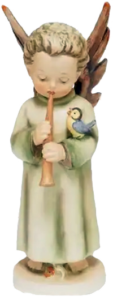
173 4/0 – 3.125 inches
173/0 – 8 inches
173 – 10½ inches
173/II – 10½ inches
Originally modeled in 1947 by master sculptor Reinhold Unger in the large size only with incised number 173. Old Crown mark TMK-1 and some Full Bee TMK-2 examples have a much larger bird and flower in front of the angel (rare). First issued with the Crown TMK-1 trademark in limited quantities as a twin to HUM 172, it too followed the same progressive changes in design, apparently at exactly the same times through the 1950s and 1960s. The unavailability at certain periods, the introduction of the smaller size, and the change in model numbering followed in parallel. The flowers also made a similar descent to below the hemline of the angel’s gown. The small size (173/0) was modeled by master sculptor Theo R. Menzenbach in 1961 and can be found in one style only. The large size (173/II) was “temporarily withdrawn” (TW) from production on 31 December 1984. A miniature size figurine, 173/4/0 in a matte finish was put on the market in 1995 with a suggested retail price of $95. It has an incised 1991 copyright date and a “FIRST ISSUE 1995” decal on the bottom. The 1959 catalog called the instrument a horn instead of a flute, as it called the mandolin a banjo with HUM 172. Some collectors feel that this version is rarer than Festival Harmony with Banjo, HUM 172. The German name, Adventsengel mit Flöte, “Advent Angel with Flute.” The original painting done by Sister Hummel is owned by Verlag Ars Sacra who used this drawing to publish postcard #14551.
HUM 174 – She Loves Me, She Loves Me Not

Height – 4¼ inches
Originally modeled by master sculptor Arthur Möeller in 1945. Issued with a Crown TMK-1 trademark in the late 1940s but was not shown in the 1947 U.S. catalog, this piece was modified before 1956 and again in the late 1960s. A premium is included in the Crown TMK-1 price for the early model with a straight-ahead pensive stare, a very small feather and no blossom midway up the upright post on the left side. The TMK-2, 3 and 4 trademark versions has a very prominent feather in the cap, a flower blossom about midway up the post on the viewer’s left, and a straight-ahead gaze. Sometime after 1967, the piece was restyled by removing the midway flower and having the boy look down at a smaller daisy and no flower on the left fence post. Deeply sculptured hair and textured jacket by Skrobek were also added. At one time, this piece was listed as “Boy Sitting Before Fence.” The German name, Lieht mich, leiht mich nicht, is the same as the English translation.
HUM 179 – Coquettes
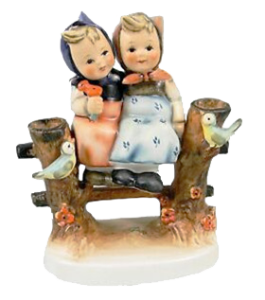
Height – 5 inches
Originally modeled by master sculptor Arthur Möeller in 1948 and has been restyled later on. An early catalog from the 1950s lists this as “Coquettes”, two girls on a fence in which there are holes for flowers. It is found in all trademarks and also incised as 179. (decimal) with a Crown TMK-1 trademark. One variation has the girl on the viewer’s right wearing a dark blue dress and holding flowers. This piece was also restyled and is found brighter and shinier in the newer models. The figurine was pictured in the March 1976 calendar. The German name of Zaungäste translates as “Fence Guests.” The original drawing is owned by Ars Sacra and has been published as a postcard #5861.
HUM 195 – Barnyard Hero
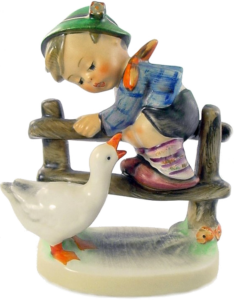
195/2/0 – 4 inches
195(.) – 5¼ to 6 inches
195/I – 5½ inches
First modeled by master sculptor Reinhold Unger in 1948. A contrast is evident between the English Barnyard Hero and the German Angthase, which is “Coward” in English. Perhaps the ironic implication of “Hero” adds a light touch to the English name. This piece was first issued with a 1948 incised copyright date, probably in the early 1950s in the U.S. which was about the time it was copyrighted here. It was available only in one size, 5½ inches high and incised 195 (only) on the underside of the base. Most models have an incised 1948 copyright date.Sometime later in the mid-1950s the smaller size was introduced, 4 inches high, incised as 195/2/0. At that time, 195/I became the indicator for the larger size. There is no indication to date that any intermediate size was issued as 195/0. In the early models of the small size, the boy’s hands are on each side of the top rail. When this was restyled, probably in the 1960s, the boy’s hands were placed one on top of the other. This figurine has been popular in calendar art, having been pictured in the annual Goebel calendars November 1954, August 1962 and August 1972. Sister Hummel’s original drawing is owned by Verlag Ars Sacra and is issued as postcard #4782.
HUM 197 – Be Patient
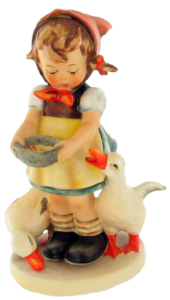
197/2/0 – 4¼ inches
197(.) – 6¼ inches
197/I – 6 inches
When first modeled in 1948 by master sculptor Reinhold Unger, this figurine was produced in one size only with the incised number 197. A smaller size was issued in the mid-1950s with the incised number 197/2/0. At the same time, the large size was changed to 197/I. Both sizes have been restyled with the new textured finish and usually have an incised 1948 copyright date. The little girl feeding ducks was first copyrighted (GP1817) in the U.S. on July 14, 1950 although incised with 1948 and issued earlier. When first issued, the figurine was incised only 197 with a Crown TMK-1 trademark and has also been reported incised as 197. (decimal) with a Full Bee TMK-2 trademark. At that time, only the 6¼ inch size was available. This designation was superseded some years later by the designation 197/I to distinguish it from the second size that was issued about 4½ inches high and incised as 197/2/0. The large size 197/I was “temporarily withdrawn” (TW) from the U.S. market only at the end of 1997. There has been some color variation in the apron; one was reported with a pink apron, TMK-4 at 4½ inches high. The old name of “Mother of Ducks” was used and later the German name of Entenmütterchen translates as “Little Duckling Mother” was used. The location of the original drawing has not been determined, but pictures of the figurine itself have been used by Goebel in the March 1962 and the August 1971 calendars.
HUM 199 – Feeding Time
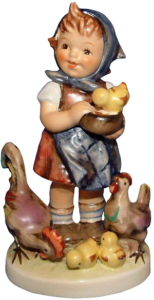
199/0 – 4¼ inches
199(.) – 5½ inches
199/I – 5¾ inches
When first modeled in 1948 by master sculptor Arthur Möeller, this figurine was produced in one size only with the incised number 199. This was registered in the U.S. Copyright Office as GP4386 on January 23, 1950. It was incised only 199 on the bottom, some with a Double Crown (incised and stamped) and was about 5½ inches tall. The girl had light golden hair. One Crown mark was found incised 199/I, indicating an early changeover in this large size because of the introduction of the small 4¼ inch size in the mid-1950s. The smaller size was designated by an incised 199/0 on the bottom. At the same time, the large size was changed to 199/I. Sometime in the early 1960s these were redesigned by master sculptor Gerhard Skrobek with a more alert expression, auburn colored hair, rougher surface texture and brighter colors. The new style featured the girl’s hand under the bowl. The small size and the new large size figurines have an incised 1948 copyright date. The small size (199/0) can sometimes be found with the old style head and the new style hand under the bowl. The German name of Im Hühnerhof translates as “In the Chicken Run.” One original Sister Hummel drawing is owned by Verlag Ars Sacra who used it to produce postcard #5943. To date, two original drawings of the Feeding Time design are known. Goebel used the picture of the figurine for their calendars in May 1968 and May 1975.
HUM 203 – Signs of Spring
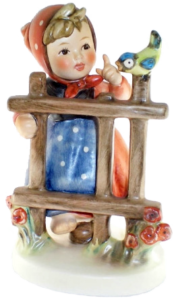
203/2/0 – 4 inches
203(.) – 5¼ inches
203/I – 5 to 5½ inches
When first modeled in 1948 by master sculptor Arthur Möeller, this figurine was produced in one size only with the incised number 203. Catalogs of the early 1950s indicate that this was first issued about that time in only the large 5¼ inch size, which was incised with the whole number 203 on the bottom of the base, or in some cases 203. (decimal). Shortly after that, when the smaller size, 4 inch high, was introduced in the mid-1950s and incised 203/2/0, the large size was changed to 203/I. There is no record to date of an intermediate size incised 203/0. One figurine found in this marking would be considered unusual. A change in design in the smaller size was instituted by removing her right shoe so that today, examples of the Full Bee TMK-2 trademark are found with and without a shoe. Any figurines in this size with TMK-2 with both shoes on would be very scarce and valued in the mid three-digit figures. A Double Crown (incised and stamped) 203 at 5¼ inches high was recently valued in this range. This piece was also copyrighted in the U.S. as GP4387 on January 23, 1950, and December 19, 1977. Newer models have an incised copyright date of 1948. The old name is “Scandal” and sometimes seen in catalogs as “Two shoe.” The German name Frühlingsidyll translates as “Spring Idyll.” Both sizes of “Signs of Spring” were permanently retired by Goebel in the fall of 1990 and will not be produced again. The 1990 retail list price was $120 for the small size and $155 for the large size. A picture of the figure was used for the month of March in the 1967 and 1973 calendars produced by Goebel.
HUM 221 – Happy Pastime, Candy Box
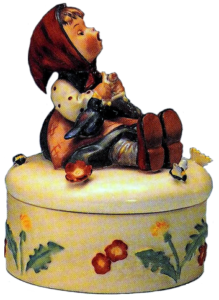
Height – ? inches
Closed Number (CN)
This candy jar was made as a sample only and was never produced for sale. First modeled by master sculptor Arthur Möeller in 1952, there are no known examples in any private collections. According to Robert Miller’s Authorized Supplement to HUMMEL, this number was originally listed as “Unknown,” as factory records indicated it as a Closed Number (CN). HUM 221 was planned at one time to be a glamorized version of the present Candy Box HUM III/69. The main difference was the addition of flowers and blossoms on the top and sides of the box which would have been very vulnerable to damage. The bird was also positioned in front of the girl and her kerchief was without polka dots. If an example of this figurine is located, it should be insured for between $3,000 and $6,000.
HUM M227 – She Loves Me, She Loves Me Not, Lamp
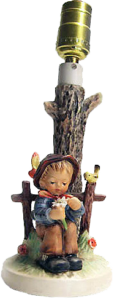
Height – 7½ inches
A 7½ inch lamp base utilizing HUM 174 as part of the design. This lamp was first modeled in 1953 by master sculptor Arthur Möeller and has been restyled several times. This lamp and its companion piece, HUM 228 Good Friends, have been made only in this 7½ inch size. It has been reported in an example of 8½ inch high which could have been an error. No lamps have been reported in that size to date and this is the only mention of this size. If found in the taller piece, it would be valued at about 25 percent higher than the price list value with a comparable trademark. This adaptation of the figurine, HUM 174 has a flower on the left fence post and eyes looking up or straight as the viewer as in some of the older figurines. On the newer models, the eyes are looking down. This lamp was “temporarily withdrawn” (TW) from production on 31 December 1989.
HUM M229 – Apple Tree Girl, Lamp
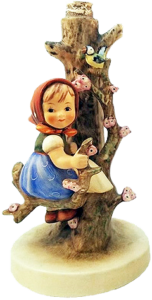
Height – 7½ inches
This was a 7½ inch lamp base utilizing HUM 141 as part of the design. This well-known figurine is a natural for a lamp because the girl is already sitting in the branches of a tree. This lamp was first modeled by master sculptor Arthur Möeller in 1953 and has been restyled several times. Introduced about 1955 in the 7½ inch high size, it was listed in a 1959 catalog as being 8½ inch high, but an 8½ inch lamp has yet to be found. On the older lamps, the figure is much larger but the post still measures only 7½ inches high and 4¼ inches across. This same model is also used in one of the pair of Bookends, HUM 252 A. There is no record of this having been made in the larger 9½ inch size as some other lamps have been. This is in current production beginning with TMK-2 however, it was “temporarily withdrawn” (TW) from production on 31 December 1989. The old name of the Apple Tree Girl is “Spring” or “Springtime.”
HUM M230 – Apple Tree Boy, Lamp
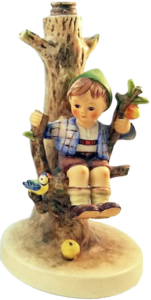
Height – 7½ inches
This was a 7½ inch lamp base utilizing HUM 142 as part of the design. This lamp was first modeled by master sculptor Arthur Möeller in 1953 and has been restyled several times. On the older lamps, the figure is much larger but the post still measures only 7The same information applies to this lamp as described for HUM 229 above. This model was also used as part of the Bookends, HUM 252 B, and the 1977 Annual Plate HUM 270, the year after the girl was used on a similar plate, HUM 269. Both lamps, HUM 229 and HUM 230, were copyrighted in the U.S. in 1955 and both pieces are known in TMK-2 through TMK-6. This is in current production beginning with TMK-2 however, it was “temporarily withdrawn” (TW) from production on 31 December 1989. The old name of the Apple Tree Boy is “Autumn” or “Fall.”
HUM 233 – Boy Feeding Birds
![]() Height – ? inches
Height – ? inches
Closed Number (CN)
Robert Miller’s Supplement to HUMMEL states that HUM 233 was the first assignment of master sculptor Gerhard Skrobek ,by W. Goebel Porzellanfabrik in 1954, to interpret one of Sister Hummel’s drawings into a figurine. The figurine was listed at that time in the factory records as being a “boy feeding birds”. It was listed as a Closed Number (CN) on 7 September 1954. For no known reasons, it was never produced and not even a factory sample or original study has been reported. It was thought that this design was restyled and became HUM 300 Bird Watcher which was not issued until 1979. The restyling may have been done shortly after Mr. Skrobek’s initial work on the figurine. This may have been evidenced since a U.S. copyright GB12632 was issued on July 18, 1956 for HUM 300 with the tentative name of “Friends of Animals.” There is no U.S. record of a copyright for HUM 233.
HUM 236 B – Cancelled Number
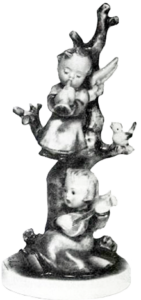
Height – 6½ inches
Original research on this number has revealed no information. Sample models were located at the Goebel factory in 1984 and were put on display at the Goebel Collectors’ Club in Tarrytown, New York. This was designed in 1954 by master sculptor Arthur Möeller but for some reason was not approved by the Sießen Convent for production. This is the only example known of this figurine located in the Goebel factory archives.
HUM 246 – Holy Family, Holy Water Font
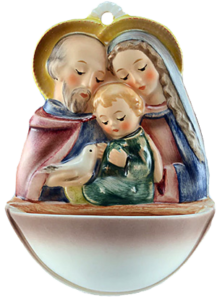
Height – 3 x 4½ inches
Master sculptor Theo R. Menzenbach modeled this font in 1955. The earliest catalog listing is in the 1955 Second Edition of Schmid Brothers. This has an incised 1955 copyright date but was not copyrighted in the U.S. until April 27, 1956 as GP12631 with the name “Madonna with Jesus and Joseph.” The font is found in all trademark periods except in the Crown TMK-1 period. The first available catalogs that list HUM 246 are dated 1959, thereafter this font appears to have been called “Holy Family.” No variations are not to be recorded. Verlag Emil Fink, the owner of the original drawing publishes this as postcard #210.
HUM 250/B – Feeding Time, Bookend
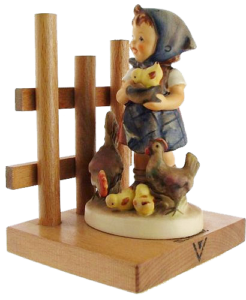
Height – 5½ inches
This half of a pair of bookends was produced by taking the figurine Feeding Time, HUM 199, and securing it to a wooden base with a simulated slat fence for the book rest. The identification and trademark are shown on the wooden base because the base of the figurine is not visible. The restyled version of the figurine which was first issued and cataloged about 1965 at a price of $26.50 for the pair, HUM 250 A&B. These bookends are normally found with TMK-3 through TMK-6. There is the possibility that one might have the earlier TMK-2 because of exceptions like this with other items by Goebel. Goebel listed these pieces as “temporarily withdrawn” (TW) from production 31 December 1989. No reinstatement date was given at the time. Factory records indicate these bookends were designed by a team of modelers in 1960 and first sold in the U.S. in 1964. One major difference I have found within this book end is the direction the girl is facing. This example shows her looking straight ahead whereas other examples may have her looking to her right toward the Little Goat Herder.
HUM 251/B – She Loves Me, She Loves Me Not, Bookend
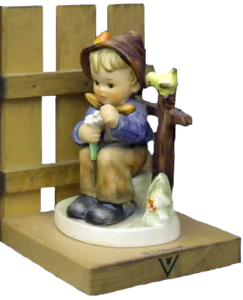
Height – 5 inches
Factory records indicate these bookends were designed by a team of modelers in 1960. First seen in the U.S. in 1964, the figurine of the boy picking petals from a daisy forms the other half of this set. The bookends are cataloged and sold as a set of two. This is a standard figurine on a ceramic base fastened to a wooden base with an upright rest for books. This is similar to She Loves Me, She Loves Me Not, HUM 174. This pair (251 A&B) was first found in a U.S. catalog dated 1965 and sets are seen in TMK-3 through TMK-6 with the possibility that some very early ones might have been marked TMK-2. Since the figurine was restyled in the mid-1970s, the bookends with TMK-5 and 6 will also show the same more modern look and coloring. Goebel listed these pieces as “temporarily withdrawn” (TW) from production 31 December 1989.
HUM 300 – Bird Watcher
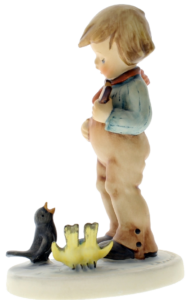
Height – 5 inches
A copyright in 1956 was registered in teh U.S. by the Goebel Company under the name of “Friends of Animals.” First sold in the U.S. with an original price of $80 in 1979, this was at one time called “Tenderness.” The demand was so great that within months of its initial release, some dealers were asking as much as $250 for it. An early sample of the figurine was modeled in 1954 by master sculptor Gerhard Skrobek and was assigned the number HUM 233 (CN). Skrobek stated that this was the first figure he modeled after starting to work at the Goebel factory in 1954. An early sample model with the Full Bee TMK-2 trademark, incised with a 1954 date, is in the Robert L. Miller collection. Early samples with the TMK-2, 3 and 4 trademarks can expect to appraise in the mid to upper thousands.
HUM 313 – Sunny Morning
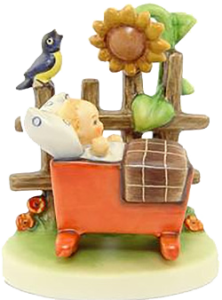
Height – 3¾ inches
This figurine was originally called “Slumber Serenade” in factory records, but later changed to “Sunny Morning.” Modeled in 1955 by master sculptor Arthur Möeller, the early sample model shown has a Full Bee TMK-2 trademark and is part of the Robert L. Miller collection. It was earlier listed on factory records as a Possible Future Edition (PFE) and has been released with possible minor modifications. This baby in a crib in front fo a fence with a huge overhanging sunflower blossom and blue bird perched nearby was assigned this number back in 1955 when it was registered in the U.S. Copyright Office as “Sunny Child.” The German name assigned to this piece is Sonnenkind which translates to “Sun Child.” In Miller’s Supplement he says it was also referred to as “Slumber Serenade.” This is one case where Sister Hummel’s usual background had to be worked into the three-dimensional version to make it a realistic adaptation. For exactly what this original drawing looks like, see postcard #5676 by Ars Sacra.
HUM 324 – At The Fence
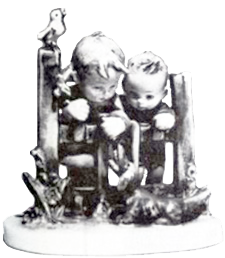
Height – 4¾ inches
Possible Future Edition (PFE)
Modeled in 1955 by master sculptor Arthur Möeller. Originally called “The Other Side of the Fence” on factory records, but later changed to “At The Fence.” The July 18, 1956 copyright filed in the U.S. Copyright Office describes this as “figures at a fence” showing two young boys in back of a section of rail fence with a long haired dachshund on the other side barking at them. This is enhanced by the usual Hummel touches of flowers and birds and is listed as an Assigned Number until and if it is released for production and sale at some time, when it will bear the current trademark. The German name is Am Zaunwhich means the same in English. A sample is in the Goebel archives as well as this early sample pictured has a Full Bee TMK-2 trademark and is part of the Robert L. Miller collection. Listed on factory records as a Possible Future Edition (PFE) and may be released at some future date, subject to minor changes. If another is found, an early price was suggested at $4,000 to $5,000.
HUM 331 – Crossroads
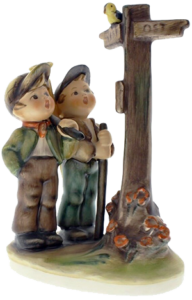
Height – 6¾ inches
Modeled by master sculptor Arthur Möeller in 1955 with an incised copyright date of 1955, this figurine was finally introduced to the U.S. market in 1972 for $45.00. 1972 was a year when twenty-four figures were listed in U.S. catalogs for the first time. This was one of them even tough the U.S. copyright was registered on July 16, 1956 using the same name, Crossroads. When first issued, the boy with the slide trombone slung over his shoulder was carrying it with the mouthpiece at the top. This was changed shortly after with the trombone in reverse position. These command a premium price somewhere between the high three-digit and low four-digit figures. This motif was pictured in the M.I. Hummel calendar for September 1977. The original drawing owned by Verlag Ars Sacra has been published as postcard #5551.
In the summer of 1990, Goebel announced a worldwide limited edition of 20,000 pieces in a uniquely altered form, to commemorate the first anniversary of the opening of the Berlin Wall. The difference between the original 1972 version and the new limited edition was significant and symbolic. Originally, midway up the signpost was a small sign which read “HALT.” Now, like so many similar signs along the East/West border, the sign lies on the ground. The original issue price of the commemorative issue was $360. During the production of this special figurine, the factory changed the trademarks. Consequently, approximately 15,000 pieces bear the TMK-6 trademark and the remaining 5,000 bear the TMK-7 trademark. The numbers were not consistent though, so it is possible to have a piece numbered 17,000 with a TMK-6 trademark. The TMK-7 trademark pieces should bring a higher price on the secondary market due to the fewer number of those pieces. A third variation was released in 1992 and was sold only through the U.S. Military base exchange stores. This edition consists of three pieces – the regular Crossroads figurine with the “HALT” sign up in the original position, but with a special colored decal of the American and the German flags on the bottom of the figurine. The second piece is a ceramic replica of the crumbled Berlin Wall. A special inscription reads: “With esteem and grateful appreciation to the United States Military Forces for the preservation of Peace and Freedom.” The same inscription is on the brass plate attached to the third piece in the set, a black hardwood display base. This limited edition consists of 20,000 sets worldwide and are hand numbered on the bottom of the Berlin Wall piece. The original military price in 1992 for this set was $265.
HUM 337 – Cinderella
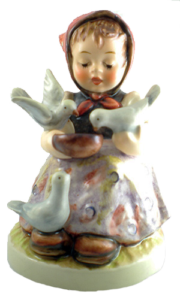
Height – 4½ inches
First introduced in the U.S. market in 1972, this was modeled by master sculptor Arthur Möeller in March of 1956 and the first sample was painted by artist Franz Kirchner in July 1956. Early models have a 1958 or 1960 incised copyright date. This girl, feeding the doves from a bowl, was copyrighted on April 4, 1961 but the figures are incised with a 1956 date. Shortly after the introduction in the U.S. in 1972, it was restyled and another copyright was issued in the U.S. Copyright Office as GF1005 on December 4, 1972 showing the incised date of 1972. This was restyled by master sculptor Gerhard Skrobek. The main deviation in the older version is that the girl is looking up or almost straight ahead, whereas in the present version, the girl is looking down. In the current model, the girl’s bangs and skirt are textured by master sculptor Skrobek. Any early examples with open eyes (up) would be worth 50 percent more than the usual Price List shows. This figure was used as the illustration for the June 1978 calendar page. No postcards or other graphics have been found and the location of the original drawing is unknown at present. The German name Aschenputtel is the same as the English, “Cinderella.” Older trademarks, such as TMK-2 and TMK-3 are considered rare. The original issue price in 1972 was $26.50. It is also found with a fourth bird on the girl’s left shoulder.
HUM 342 – Mischief Maker
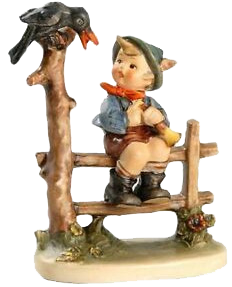
Height – 5 inches
Originally modeled by master sculptor Arthur Möeller in 1956, reports of this model being incised with copyright dates of 1958 and 1960 are somewhat earlier than the date on the registry in the U.S. Copyright Office, which is April 12, 1961 with GP28612. It was first listed for sale at 5 inches high in the U.S. 1972 catalogs, priced at $26.50, and has been found identified with TMK-4, TMK-5 and TMK-6. It would be possible that earlier prototype pieces may even have a TMK-2 or TMK-3 trademark. No important variations in design or color have been reported other than the older models having a dark green hat on the boy while newer models have a blue hat. The German name for this figurine, Der Störenfried, is essentially the same as the translated English name. A picture of this motif appears in the calendar for July, 1977. A postcard, #5328, was published by Ars Sacra who own the original drawing.
HUM 344 – Feathered Friends
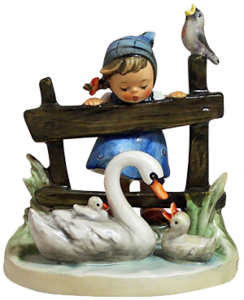
Height – 4¾ inches
First introduced in the U.S. market in 1972 for $27.50, this figure was modeled by master sculptor Gerhard Skrobek in 1956 with an incised 1956 copyright date on the base. When it was copyrighted in the U.S. on July 18, 1957 as GP15365, the figure carried the name “Feathered Friends.” A Full Bee TMK-2 and an early Stylized TMK-3 trademark examples have appeared on the market. The TMK-2 piece was probably one of the approval samples or small test lots and was insured for $2,000. The German name of Schwanenteich roughly translates as “Swan Pond.” The fact that it is found with TMK-4 through TMK-6 may indicate that it was probably produced before 1972 when the TMK-5 trademark was introduced. No major revisions in the design or color have been reported, though this does not preclude the discovery of an interesting variation. A picture of this motif was used for the month of June in the 1977 calendar year. Postcard #5620 has been published by Verlag Ars Sacra who owns the original drawing.
HUM 351 – The Botanist
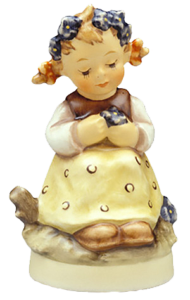
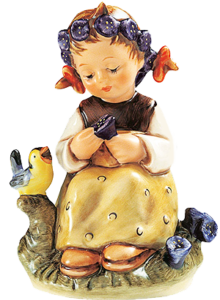
Height – 4 to 4¼ inches
This figurine was first modeled by master sculptor Gerhard Skrobek in 1965 with an incised copyright date of 1972 on the bottom and introduced in the U.S. market in the fall of 1982. Originally called “Remembering” on old factory records, but later changed to “The Botanist” and finally just “Botanist.” The original price was $82 in 1982 and has been found with an earlier incised copyright date of 1965. An early sample with a TMK-4 trademark could bring a value of $2,000 to $3,000. This is an adaptation of one of Sister Hummel’s drawings showing a seated girl studying a scarce gentian blue flower held in her hand, apparently after some fashioning of some of them into a garland she wears around her head. A pert little blue bird is perched on a small stump at her right that seems to be talking directly to her. The adaptation was registered in the U.S. Copyright Office on May 30, 1972 with the unimaginative name of “Girl Holding Flowers.” Fortunately, a prototype was located in the Goebel factory archives as described but for some reason it has remained in a state of suspension. The German name assigned to this motif is Enzian-Mädchen or “Girl with Gentian Flowers.” Ars Sacra owns the original drawing and have produced an exact replica as the postcard #5860. I was able to locate a variation of this motif without the blue bird and a different arrangement of the flowers to the girls left as shown here. The base is also quite different and there appears to be less detail indicative of a possible smaller version which in this case is the three inch figurine, HUM 351/4/0.
HUM 352 – Sweet Greetings
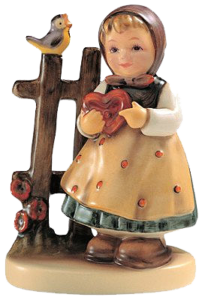
Height – 4¼ inches
Assigned Number (AN)
Modeled by master sculptor Gerhard Skrobek in 1964, it was first released in the U.S. market in 1981 with an issue price of $85. Originally called “Musical Morning” on old factory records, but later changed to “Sweet Greetings.” HUM 352 was registered in the U.S. Copyright Office as GF291 on September 9, 1965 and briefly described in the document by the name, “Girl Standing by Fence.” Further investigation by Robert Miller with the help of the Goebel Company uncovered a model of this piece in the company archives. The prototype shows a small, 4¼ inch girl standing in front of a rail fence holding a large red heart in front of her with both hands. A mascot bird perched on the post at her right seems to be chirping instructions to her vehemently. It has an incised copyright date of 1964 on the bottom and to date, no other examples have been located with older trademarks. If another authenticated sample were ever found, it would be valued in the mid four-digit range. When and if the Goebel Company decides to reclassify this from an “Assigned Number” to join the hundreds of other pieces currently offered for sale, these production pieces, while marked with the same copyright year, would be labeled with the current trademark in use at that time. The German name, Ein süsser Gruss means essentially the same as the English one. The central figure in the original drawing published by Ars Sacra, postcard #5835, was probably the inspiration for this figurine.
HUM 354 C – Angel With Bird and Cross,
Holy Water Font
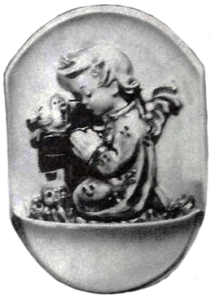
Height – 3¼ x 5 inches
Closed Number (CN)
This early prototype font has the incised number 356 only, on the back. According to factory information, this design was not approved by the Sießen Convent as a font. It was then restyled into a figurine and approved as HUM 358 “Shining Light.” This is now listed on factory records as a Closed Number. In the first edition of HUMMEL by Eric Ehrmann, this number was listed as a Closed Number, one that was never used and never would be used. Further research by Robert Miller and the factory disclosed a trinity of font prototypes which are aptly described by the name and letter. The abstract of the U.S. copyright may be incomplete as it shows only that HUM 354 was registered as GP28607 on April 21, 1961 with the name assigned as “Kneeling Angel with Horn.”
HUM 356 – Gay Adventure
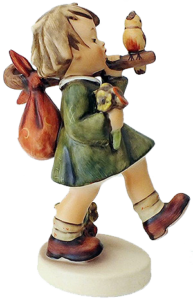
Height – 4¾ inches
Originally modeled by master sculptor Gerhard Skrobek in 1963, it has an incised 1971 copyright date on the bottom and was copyrighted December 3, 1971 as GF770. It was originally called “Joyful Adventure” when released in the U.S. market in 1972 for $22.50. It has been cataloged over the years ranging from 4¾ inches to the current 5 inches in height. It has been slightly restyled with the new textured finish on current models whereas early models have slightly different construction on the underside of the base. The German name of Frohes Wandern translates as “Happy Wandering.” It was used as the illustration for September in the 1978 calendar. The original drawing is owned by Verlag Ars Sacra, and graphics from this were produced by them as postcards #14905 and #5607. An early sample with a TMK-3 may bring as much as $2,000 to $3,000.
HUM 360/A /B /C – Boy and Girl, Boy, Girl,
Wall Vases
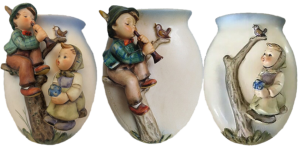
Height – 4½ x 6 inches
A set of three wall vases that have been considered rare but is again in current production with the TMK-5 and TMK-6 trademarks. According to factory records, this vase was modeled by master sculptor Gerhard Skrobek in 1959. Early models with the TMK-3 trademark are incised on the back with “Ⓒ by W. Goebel 1958.” The new model reissued in 1979 has been slightly restyled and has a copyright date of 1958 only incised on the back. It was “temporarily withdrawn” (TW) from production on 31 December 1989. The HUM 360/C Girl Wall Vase model reissued in 1979 has the trunk of the tree slightly restyled and has the copyright date of 1958 only incised on the back side.
HUM 379 – Don’t Be Shy
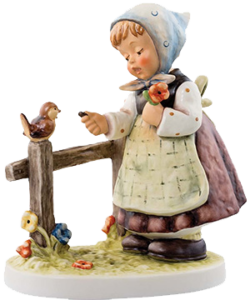
Height – 4¼ to 4½ inches
Possible Future Edition (PFE)
This figurine was first modeled by master sculptor Gerhard Skrobek in February 1966, it is now listed on the Goebel factory records as a Possible Future Edition (PFE) and may be released at some future date, subject to possible minor changes. The copyright record found in 1976 indicated differently as it is listed with this number already registered in the U.S. as GF833 on May 30, 1972 and described as “Little girl feeding a bird on a fence,” at 4½ inches high. In Robert Miller’s Supplement to the book HUMMEL, he states that this was assigned as early as 1966 when Gerhard Skrobek sculpted the model. It depicts a small girl with kerchief on her head standing in front of a section of a split rail fence, feeding a bird on the fence, and holding a flower in the crook of her left arm. If and when this piece is released for production and sale, it will probably be incised with a copyright date of 1966 and be identified by the trademark being used at release time. It was found with a TMK-3 trademark and valued with a market value of between $4,000 and $5,000. The original drawing of this subject by Sister Hummel is owned by Verlag Emil Fink who produces the postcard #698 as an exact replica. The German name of Da, nimm’s doch means “Here, take it.”
HUM 382 – Visiting an Invalid
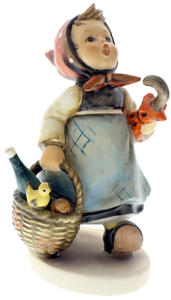
Height – 5 inches
Originally modeled by master sculptor Gerhard Skrobek in October 1966, it has an incised date of 1971 copyright date on the underside of the base being copyrighted on December 3, 1971 with the U.S. Copyright Office as GE769. It was first released in the U.S. market in 1972 with an issue price of $26.50 in a 1972 distributor’s catalog. It has also been found with a copyright date of 1967 incised on the bottom. This little girl strides along carrying a basket with a bottle in it accompanied by the little bird which has become almost as much of an M.I. Hummel symbol as the small button-type flowers used in so many designs. The German name for this model is Krankenbesuch and translates as “Visit to a Patient.” It is identified with either TMK-4, 5 or 6. A picture of this figurine was used for the month of January for the 1977 calendar. So far, there have been no important changes in size, color, or design reported. The original drawing is owned by Verlag Emil Fink, from which a graphic was published by them as postcard #810.
HUM 385 – Chicken-Licken
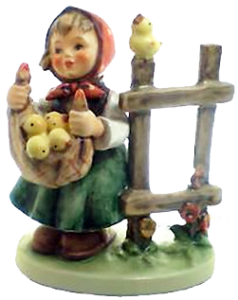
Height – 385/4/0 – 3¼ inches
Height – 385 – 4¾ inches
Originally modeled by master sculptor Gerhard Skrobek in June 1967, it has an incised 1971 copyright date on the bottom of the base. It was first introduced in the U.S. market for $28.50 in 1972 as one of twenty-four new motifs released that year. This figurine of the girl holding the basket of chicks in front of her is also called “Chicken Liesl” which is the translation of the German, Kükenliesl. However, Chicken-Licken was the name under which the copyright was registered in the U.S. on December 3, 1971. To date, there has been no indication that there are any variations of this motif in color, size, or design which would be worth a premium over the regular models. The M.I. Hummel calendar for July, 1980 shows an interesting photograph of this motif. It not only is pictured in a naturalized setting disguising the base, but a special model must have been made up for that purpose, as the clothing shows very pronounced texturing and the hair is highly sculptured. It appears to have been made by Gerhard Skrobek. The original drawing is owned by Ars Sacra and a graphic has been published by them as postcard #5833.
A new miniature size figurine, without the fence, was issued in 1991 with a suggested retail price of $80 to match a new miniature plate series called the “Little Homemakers” – one each year for four years. This is the fourth and last in the series. It has an incised 1987 copyright date. The miniature size (385/4/0) was “temporarily withdrawn” (TW) from production on 31 December 1997.
HUM 387 – Valentine Gift

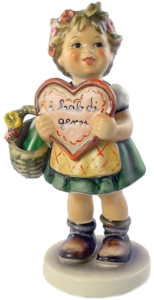
387 – 5¼ inches
387/III – 13¼ inches
Closed Edition (CE)
This very special Limited Edition figurine was first introduced in 1977 for members of the Goebel Collectors’ Club only and not sold in Open Edition. The number produced did not exceed one for each first-year member of the Goebel’s Collectors’ Club. The Goebel Club says the membership was “over one hundred thousand” at that time. Despite that figure, there are many times that number who want the figure, with the result that it has been resold for five to eight times the issue price. Originally modeled by master sculptor Gerhard Skrobek in July 1967, it has an incised 1972 copyright date along with the TMK-5 trademark. The design was registered in the U.S. Copyright Office on May 30, 1972, as GF829. It also bears the inscription, “EXCLUSIVE SPECIAL EDITION No. 1 FOR MEMBERS OF THE GOEBEL COLLECTORS’ CLUB” applied by blue decal. The original issue price was $45 in addition to the member’s redemption card. 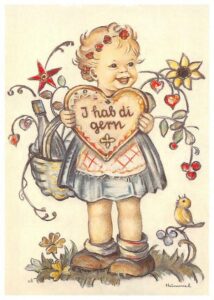 A postcard, #5940 was published by Ars Sacra who own the original drawing. Translation of message on the heart is “I Love You Very Much” or “I Like You.” Several examples without the special inscription exist but with the TMK-4 trademark only have appeared on the market. Some have a 1968 or a 1971 copyright date and usually sell for between $2,000 and $3,000. The version with a bird sitting on the top of the heart commands a higher estimate of between $5,000 and $7,500. That is one expensive bird. The larger version does have a yellow bird to the left of the girl sitting on a flower on the ground.
A postcard, #5940 was published by Ars Sacra who own the original drawing. Translation of message on the heart is “I Love You Very Much” or “I Like You.” Several examples without the special inscription exist but with the TMK-4 trademark only have appeared on the market. Some have a 1968 or a 1971 copyright date and usually sell for between $2,000 and $3,000. The version with a bird sitting on the top of the heart commands a higher estimate of between $5,000 and $7,500. That is one expensive bird. The larger version does have a yellow bird to the left of the girl sitting on a flower on the ground.
HUM 393 – Dove, Holy Water Font
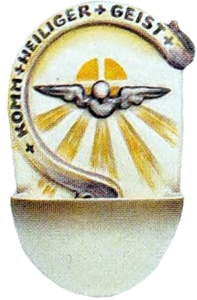
Height – 2¾ x 4¼ inches
Possible Future Edition (PFE)
This holy water font was modeled by master sculptor Gerhard Skrobek in June 1968. There was no record found of the registration of the design in the U.S. Copyright Office. The inscription reads: “Come Holy Spirit.” It is listed on factory records as a Possible Future Edition (PFE) and may be released at some future date, subject to possible minor changes. It was recently found with a TMK-4 trademark and a 8/69 painting date and now resides in the Robert L. Miller collection and is pictured in his Supplement to the original HUMMEL book. The dove is the religious representation of the Holy Spirit and the words on the banner in German are Komm Heiliger Geist for “Come Holly Spirit (Ghost).” A post card, #5916, is a reproduction of the original drawing owned by Ars Sacra. Appraisal price is around $2,000 to #3,000.
HUM 399 – Valentine Joy
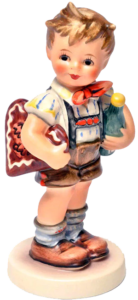
Height – 5¾ or 6¼ inches
Closed Edition (CE) Originally modeled by master sculptor Gerhard Skrobek, it has an incised 1979 copyright date along with the TMK-6 trademark. The figurine was first introduced in 1980 for members of the Goebel Collectors’ Club only and not sold as an Open Edition. It bears the inscription, “EXCLUSIVE SPECIAL EDITION No. 4 FOR MEMBERS OF THE GOEBEL COLLECTORS’ CLUB” applied in blue decal on the bottom. The original issue price was $95 in the U.S. and $105 in Canada, in addition to the member’s redemption card. Translation of the message on the heart is somewhat more restrained Valentine greeting I mag di, meaning “I Like You.” The early sample of this piece is larger in size, has a rounded base showing grass and has a bird at the boy’s feet. It has an incised 1973 copyright date along with the TMK-5 trademark. No registration of this number and assigned motif was found in the U.S. copyright records.
Originally modeled by master sculptor Gerhard Skrobek, it has an incised 1979 copyright date along with the TMK-6 trademark. The figurine was first introduced in 1980 for members of the Goebel Collectors’ Club only and not sold as an Open Edition. It bears the inscription, “EXCLUSIVE SPECIAL EDITION No. 4 FOR MEMBERS OF THE GOEBEL COLLECTORS’ CLUB” applied in blue decal on the bottom. The original issue price was $95 in the U.S. and $105 in Canada, in addition to the member’s redemption card. Translation of the message on the heart is somewhat more restrained Valentine greeting I mag di, meaning “I Like You.” The early sample of this piece is larger in size, has a rounded base showing grass and has a bird at the boy’s feet. It has an incised 1973 copyright date along with the TMK-5 trademark. No registration of this number and assigned motif was found in the U.S. copyright records. 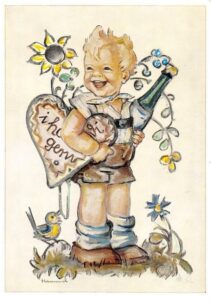 The original drawing by Sister Hummel is owned by Verlag Ars Sacra who produce an exact replica of it as postcard #5939. The smaller size was selling for around $300 to $350 whereas the much more limited early sample with the bird at the feet could be found for $5,000 to $7,500.
The original drawing by Sister Hummel is owned by Verlag Ars Sacra who produce an exact replica of it as postcard #5939. The smaller size was selling for around $300 to $350 whereas the much more limited early sample with the bird at the feet could be found for $5,000 to $7,500.
HUM 402 – True Friendship
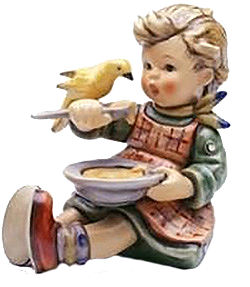
Height – 4¾ inches
Possible Future Edition (PFE)
This figurine was first modeled by master sculptor Gerhard Skrobek in 1973. It features a seated girl eating porridge from a bowl held in her left hand while her right had holds a spoonful and a bird is perched on her right forearm. Presently listed on the Goebel factory records as a Possible Future Edition (PFE) and may be released at some future date, subject to possible minor changes. There have been found a few early samples with the Last Bee mark TMK-5 and may sell for close to $3,000 each.
HUM 405 – Sing With Me
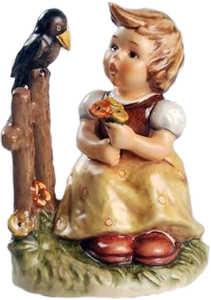
Height – 5 inches
This figurine was first released in the U.S. market in 1985 along with three other new models formerly listed as Possible Future Editions (PFE). Modeled by master sculptor Gerhard Skrobek in 1973, it has an inscribed 1973 or 1974 copyright date on the bottom. The original issue price was $125 in the U.S. and $158 in Canada. Sing With Me was temporarily withdrawn from production in January of 1999. There have not been found any significant variations that affect the collector value.
HUM 408 – Smiling Through
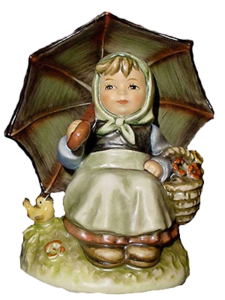
Height – 408 – 5½ inches
Height – 408/0 – 4¾ inches
This figurine was first introduced in 1985 for members of the Goebel Collector’s Club only and not sold as an Open Edition. Originally modeled by master sculptor Gerhard Skrobek from an original drawing by Sister Hummel. It has an incised 1983 copyright date along with the TMK-6 trademark and bears the inscription, “EXCLUSIVE SPECIAL EDITION No. 9 FOR MEMBERS OF THE GOEBEL COLLECTORS’ CLUB” applied by blue decal. The original issue price was $125 in the U.S. and $165 in Canada in addition to the member’s redemption card. It is interesting to note the incised model number of 408/0, which indicates that more than one size was produced. The club piece was designed to be smaller, more uniform in size to the other club figurines. The club figurine was listed at a value of $350 to $375 whereas the larger early sample size was listed for $4,000 to $5,000.
HUM 413 – Whistler’s Duet
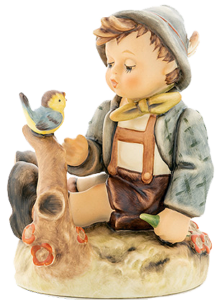
Height – 4 inches
his figurine was first modeled by master sculptor Gerhard Skrobek in 1979. It was initially released in the U.S. market in the fall of 1991 with an original issue price of $235. The TMK-5 is very rare yielding an estimated value of at least $3,000 to $4,000. One with a TMK-6 can bring a value of about $500 to $1,000. The piece was temporarily withdrawn from production in June 15, 2002. The figurine is a good compliment to the little girl version HUM 414 In Tune.
HUM 414 – In Tune
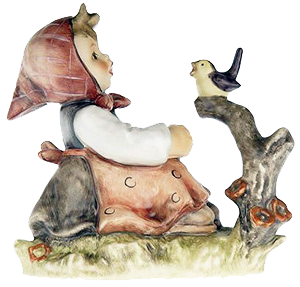
Height – 4¼ inches
Modeled by Gerhard Skrobek in 1979, this was first released in the U.S. market in 1981 with an original issue price of $115. This figurine was designed to match the fourth edition of the annual bell series, HUM 703 In Tune 1981 Annual. The figurine has an incised 1979 copyright date on the bottom of the base. This same motif was used on HUM 297 Springtime Serenade plate in 1997. The TMK-5 is very rare yielding an estimated value of at least $3,000 to $4,000. The figurine is a good compliment to the little boy version HUM 413 Whistler’s Duet.
HUM 426 – Pay Attention
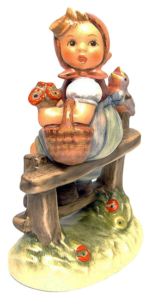
Height – 5¾ inches
This figurine was first modeled by master sculptor Gerhard Skrobek in 1980 and has an incised 1981 copyright date. It was until recently listed on factory records as a Possible Future Edition (PFE). When this figurine was initially placed into production, it was not the 5¾ inch size but rather was a smaller 4¼ inches with a designation of 426/3/0 having been crafted by Helmut Fischer in 1997 and released in 1999. This larger size, bearing a TMK-6, is now considered an early sample. The figurine depicts a girl sitting on a fence while holding flowers and a basket. She is looking away from a crowing black bird perched on the fence post next to her. The original issue price was $175. In 2011, the 75th anniversary of the beginning of Sister Hummel’s legacy was marked with Manufaktur Rödental selecting 50 figurines to bear the “75th Anniversary” backstamp. Pay Attention was one of these. Only 75 of these were available in North America with this backstamp. Each figurine is hand-numbered with a golden backstamp and a map of North America backstamp as well. A special porcelain plaque was included as well as a “75 Years of M.I. Hummel” certificate. This motif is also used on HUM 299, the 1999 Autumn Glory plate.
HUM 427 – Where Are You?
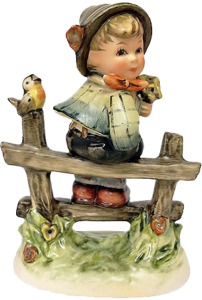
Height – 5¾ inches
This figurine was first modeled by master sculptor Gerhard Skrobek in 1980 and has an incised 1981 copyright date. As with the HUM-426 Pay Attention, the HUM 427 Where Are You? figurine was initially also placed into production with the larger 5¾ inch size being replaced soon with a smaller 4¼ inches with a designation of 427/3/0 having been crafted by Helmut Fischer in 1997 and released in 1999. This larger size, bearing a TMK-6, is now considered an early sample. The boy sits on a fence and holds a bouquet of flowers while a bird is perched on a fence post. The original 1999 issue price was $175. This would make a nice companion piece with HUM-426 Pay Attention.
HUM 430 – In D Major

Height – 4¼ inches
This figurine, also known as Let’s Sing, was modeled by master sculptor Gerhard Skrobek in 1980 and was first released in the U.S. market in 1989 with an original issue price of $135. In the rear view, the “K B” on the boundary stone the little boy is sitting on means: “Koenigreich Bayern” which translates into English as “Kingdom of Bavaria.” There have not been any significant variations found to affect the value, although the piece was temporarily withdrawn from production on June 15, 2002.
HUM 433 – Sing Along
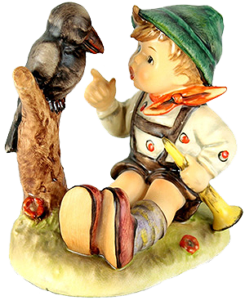
Height – 4½ inches
Modeled by master sculptor Gerhard Skrobek in 1981 and was first released in the U.S. market in 1987 for an original issue price of $145 in the U.S. and $200 in Canada. This figurine was designed especially to match the ninth edition of the annual bell series, HUM 708 Sing Along, the 1986 annual. There have not been any significant variations found to affect the value, although the piece was temporarily withdrawn from production on January of 1999.
HUM 442 – Chapel Time, Clock
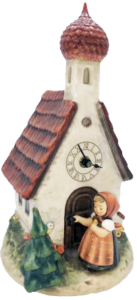
Height – 11½ inches
Closed Edition (CE)
This figurine is an actual working clock that was first modeled by master sculptor Gerhard Skrobek in 1982. It has an incised 1983 copyright date. It was released in 1986 being produced for one year only as a limited edition and was not produced again in the twentieth century. Beneath the base is a hand lettered XX to signify the twentieth century. The suggested retail price was $500 in the U.S. and $650 in Canada. Several variations are noted: Early production of Chapel Time had a closed bell tower with only painted windows. In later production, the bell tower windows were opened to allow air to escape more easily during the firing process. A third variation is in the small round window directly beneath the bell tower but above the clock. Slight variations have been noted in the base construction and color variations on the face of the clock. The clock is battery operated, using one “C” cell battery and keeps accurate time.
HUM 448 – Children’s Prayer
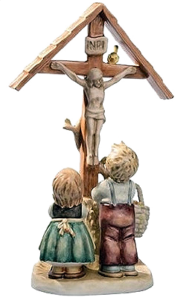
Height – 8¼ inches
Children’s Prayer is an 8¼ inch figure of a boy and a girl standing, looking up at a roadside shrine of Jesus on the cross. This beautiful figurine was modeled by master sculptor Gerhard Skrobek in 1983 and has an incised 1984 copyright date. An earlier sample did not have the small roof covering and may bring a greater value due to the fewer copies. There is a small yellow bird on the horizontal portion of the cross looking down at the two children.
HUM 455 – The Guardian
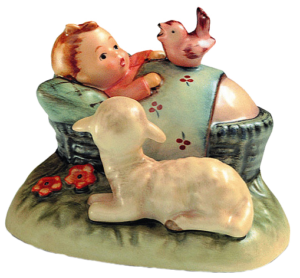
Height – 3½ inches
First released in the U.S. market in 1991, this was modeled by master Gerhard Skrobek in 1984 with an incised copyright date of 1985. The original issue price was $140. It has been noted that there are two different base constructions on this figurine and also produced without the bird as part of the “Personal Touch Personalization” program. This figurine, minus the bird can be personalized with a name or date by a Goebel artist for a $20 fee.
HUM 462 – Tit for Tat
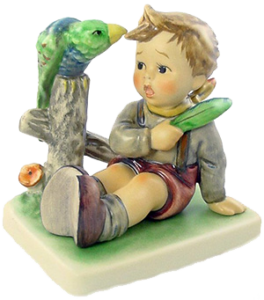
Height – 3¾ inches
This figurine was first modeled by master sculptor Gerhard Skrobek in 1984. The 3¾ inch figurine shows a rather large bird grabbing the child’s hair possibly due to the child holding what appears to be a freshly pulled feather from the bird. The piece was first released in 2004 with an incised date of 1985 copyright date and TMK-8. Limited editions of 600 have the Caribbean Collection backstamp, a band of flowers on the side of the base, and “First Issue 2004” backstamp.
HUM 633 – I’m Carefree

Height – 4¾ x 4¼ inches
Modeled by master sculptor Helmut Fischer in 1990, it was first released in the U.S. market in 1994 for an official issue price of $365. It has an incised 1990 copyright date and the “First Issue 1994” oval decal on the bottom. The incised “M.I. HUMMEL” signature is located on the rear of the wagon on early production figurines, but later changed to the left side of the wagon because of production problems. The left side is the side with the boy facing front. It is estimated that there are fewer than 1,000 pieces that have the signature on the rear which places the estimated value at $750 to $900 vs. an approximate value of $400 for the later version.
HUM 635 – Welcome Spring
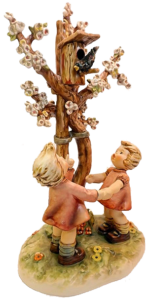
Height – 12¼ inches
Modeled by master sculptor Helmut Fischer in 1990, it has an incised 1990 copyright date and was first released in the U.S. market in 1993 for an original issue price of $1,085 in 1993. This is the eighth figurine in the Century Collection and was produced for only one year in the twentieth century. A circular inscription is applied by a blue decal and reads: “M.I. HUMMEL CENTURY COLLECTION 1993 XX” and the name “Welcome Spring” along with the TMK-7 trademark. An estimated value of between $1,500 and $1,800 was given to this item. The surprised children appear to be occupied with the vocal black bird which is letting them know this is it’s home in the bird house.
HUM 676 – Apple Tree Girl, Candle Stick Holder
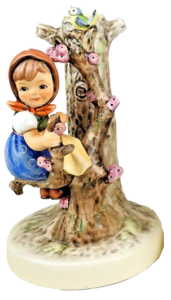
Height – 6½ inches
Closed Edition (CE)
Modeled by master sculptor Helmut in 1989 and incised with a 1988 copyright date, the initial issue price was $142.50 plus sales tax and $3.00 shipping and handling. This was initially released in the U.S. market in 1989 and sold exclusively by mail order through the Danbury Mint of Norwalk, Connecticut at a rate of one candle stick holder every three months. This was the first in the selection and has a little bird sitting in the very top of the holder.
HUM 677 – Apple Tree Boy, Candle Stick Holder
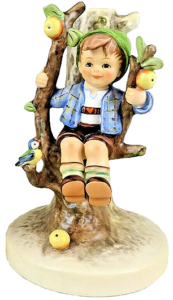
Height – 6½ inches
Closed Edition (CE)
Modeled by master sculptor Helmut in 1989 and incised with a 1988 copyright date, the initial issue price was $142.50 plus sales tax and $3.00 shipping and handling. This was initially released in the U.S. market in 1989 and sold exclusively by mail order through the Danbury Mint of Norwalk, Connecticut at a rate of one candle stick holder every three months. This was the second in the selection and has a little bird sitting on a lower limb near the boys right knee.
HUM 678 – She Loves Me, She Loves Me Not, Candle Stick Holder
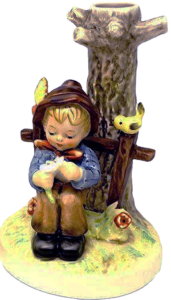
Height – 6½ inches
Closed Edition (CE)
Modeled by master sculptor Helmut in 1989 and incised with a 1989 copyright date, the initial issue price was $142.50 plus sales tax and $3.00 shipping and handling. This was initially released in the U.S. market in 1990 and sold exclusively by mail order through the Danbury Mint of Norwalk, Connecticut at a rate of one candle stick holder every three months. This was the third in the selection and has a little bird sitting on a fence post studying the flower petal pulling by the little boy.
HUM 690 – Smiling Through, Plaque
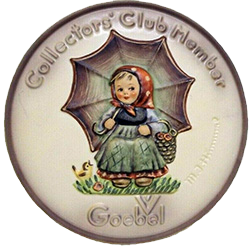
Height – 5¾ inches
Closed Edition (CE)
Originally modeled by master sculptor Gerhard Skrobek from an original drawing Sister M.I. Hummel. This round plaque was first issued in 1978 for members of the Goebel Collector’s Club only and not sold as an Open Edition with an original issue price of $50 in the U.S. and $55 in Canada in addition to the member’s redemption card. There is nothing inscribed on the back but it does have the inscription, “EXCLUSIVE SPECIAL EDITION No. 2 HUM 690 FOR MEMBERS OF THE GOEBEL COLLECTORS’ CLUB” is applied by blue decal with the TMK-5 trademark and “W. Germany 1978.” No holes are provided for hanging. This plaque can be purchased on the secondary market for premium prices now. The same motif of “Smiling Through” was made into a figurine HUM 408 and released in 1985 as “EXCLUSIVE SPECIAL EDITION No. 9” for members of the Goebel Collectors’ Club.
HUM 766 – Here’s My Heart
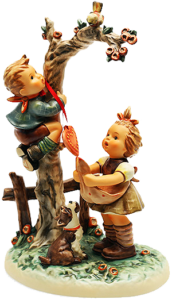
Height – 10¾ inches
This was modeled by master sculptor Helmet Fischer in 1994 and has an incised date of 1994 and was sold with an original issue price of $1,375 in 1997. It was first released in the U.S. market in the fall of 1997 as the 13th figurine in the Century Collection and was produced for that one year only in 1998 in the twentieth century. A circular inscription applied by blue decal reads: “M.I. HUMMEL CENTURY COLLECTION 1998 XX” and the name “Here’s My Heart” along with the TMK-7 trademark.
International M.I. Hummel Figurines
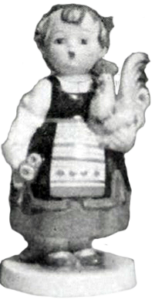
The following M.I. Hummel figurines are the original “Hungarian” figurines discovered in 1976 by a man in Vienna, Austria. He had acquired them from a lady in Budapest, who had purchased them at a weekly flea market one at a time over a six month period. He in turn sold them to collector Robert L. Miller as a gift for his wife Ruth. In 1940, the W. Goebel company decided to produce a line of M.I. Hummel figurines in the national dress of other countries. Sister M.I. Hummel made many sketches of children in their native costumes. Master modelers Reinhold Unger and Arthur Möeller then turned the sketches into the adorable figurines following. Due to the events of World War II, production of the International Figurines series was not started. Approximately thirty-three samples have bee located and the figurines with birds are shown here. Since 1976, several duplicates of some models and new variations of others have been found, usually selling in the $10,000 to $15,000 price range depending upon the condition.
HUM 807 – International, Bulgarian See above
The girl above is credited as being molded by master sculptor Arthur Möeller. This young girl in the country dress is holding a chicken in her left arm. The lower part of the dress is red and the chicken is a bright pastel yellow in color.
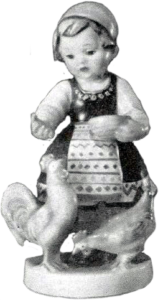
HUM 809 – International, Bulgarian
The girl to the right is credited as being molded by Arthur Möeller. The girl in the white sleeved blouse and dark blue country dress is feeding two chickens from a bowl.
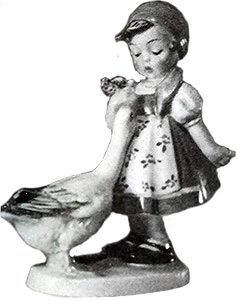
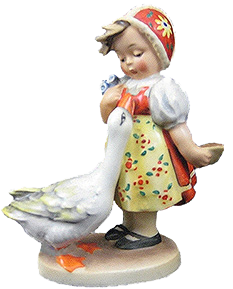
HUM 842 A and B – International, Czech Girls
The girl in the black and white photograph to the right showing her Czech clothing is credited as being molded by master sculptor Reinhold Unger and illustrates the desired intent to address the country’s attire with the very colorful outfit in contrast to the Goose Girl seen in figurine HUM 47. I was able to locate a color photograph of different Czech Goose Girl in her yellow apron over her red dress. I will continue to look for more photographs that will show the vibrant colors not typically seen like this in any of the other Hummel figurines.
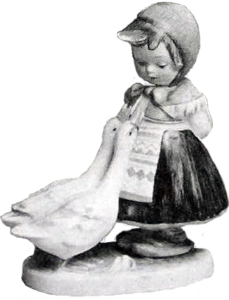
HUM 947 – International, Serbian
This one is credited as being molded by Arthur Möeller. The girl in the country dress is a Serbian version of the popular Goose Girl, HUM 47. Notice that this one has two geese as opposed to those of HUM 842.
HUM 2097 – Can I Play?
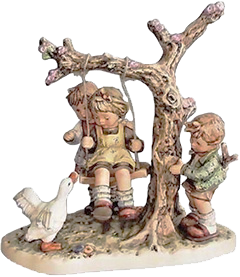
This is the fifth figurine in the “Moments in Time” collection. Limited to only 3,000 as a limited edition, it has an incised date of 2003 and was released in 2006 with a backstamp of “Moments in Time” and a trademark of TMK-8. One of a few figurines to used mixed media by incorporating twine rope for the swing. The goose in the foreground appears to have the direct attention of the three children despite the boy hiding behind the tree having protection with a sling shot in his back pocket.
HUM 2187 – Benevolent Birdfeeder
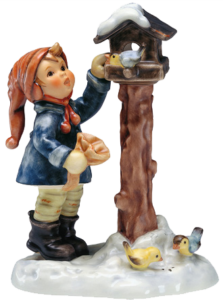
Height – 5½ inches
Nothing reflects the holiday spirit more than this kind M.I. Hummel child, caring for her feathered friends on a snowy day. It’s the perfect way to share the joy of giving, at Christmas time or any time. Made in Germany.
HUM 2190 – Harvest Time
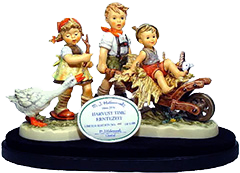
Height – 8¾ inches
Harvest time is inspired by the tradition of the harvest shared by people all over the world. This figurines brings together the Goose Girl and a pair of boys and a wheelbarrow. This figurine took 43 individual molds to be created. Only one thousand were created and were individually numbered to reflect the limited edition. Helmut Fischer was the master sculptor of this TMK-8 figurine. The entire piece rests on a wooden display with a ceramic plaque showing that it is a limited version. It was released in 2003 as a companion piece to the HUM 220: Autumn Time. The current value is placed at $3,500.
HUM 2255 – Forever Friends
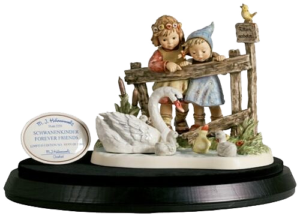 Height – 10¼”
Height – 10¼”
Forever Friends was sculpted in 2006 by master sculptor Helmut Fischer and released in 2007 with a trademark of TMK-8. Two children stand at a fence observing a swan and its goslings in this timeless Hummel. Goebel only made 1,000 figurines of this limited-edition Hummel worldwide with 500 of those sent to the U.S., each being hand numbered. Originally, this Hummel came with a porcelain identification plaque. Figurines that still have this plaque are especially valuable. This figurine is very similar to the much simpler HUM 344 Feathered Friends where there is only the one little girl in the blue outfit.
HUM 2342 – Ready or Not
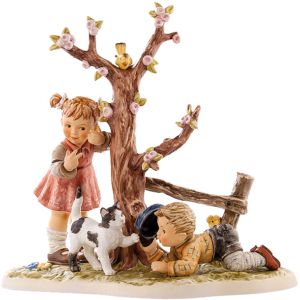 Height – 9¼”
Height – 9¼”
This figurine is the eleventh edition of the “Moments in Time” with a TMK-9 trademark in a limited edition of only 1,999 pieces worldwide. Each figurine is numbered with a certificate showing the authenticity. It shows a little boy and girl playing a game of hide-and-seek with the young girl counting to ten and the little boy hiding. A black and white cat tries to give away the little boy’s hiding place while the little yellow bird sitting in the tree watches.
HUM 2394 – Birds of a Feather
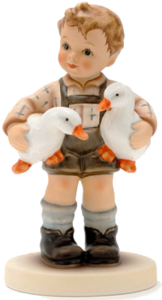
Height – 4¾ inches
Matching “Just Ducky” (Hum No. 2393), the 2018 Hummel collection also introduces “Birds of a Feather”. The young boy, distinguished by precision hand craftsmanship, holds two ducklings. The animals are particularly noticeable with their glossy white color created by a special production process. Like some other figurines, the boy wears typical Bavarian leather pants (Lederhosen). The creator of the artistic works leading to the figurines, Convent Sister Maria Innocentia Hummel, was from Bavaria.
MEL 6 – Candy box with Child in Bed
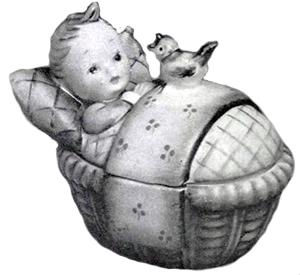
This one is credited as being molded by Arthur Möeller in 1945. An older appraisal shows this to be valued at $2,000 to $3,000. Used as a box, this one has a little bird sitting on top of the blanket with the child. All “Mel” items were discontinued in 1962 according to the Goebel factory information.
MEL 7 – Candy box with Sitting Child on Top
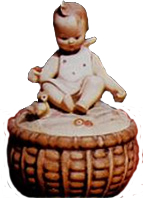
This one is credited as being molded by Arthur Möeller in 1945. An older appraisal shows this to be valued at $2,000 to $3,000. Used as a box, this one has a little bird with the child. All “Mel” items were discontinued in 1962 according to the Goebel factory information.
References
Hotchkiss, J. F., & Cassidy, C. (1981). Hummel art II. Des Moines, Iowa: Wallace-Homestead.
Hotchkiss, J. F., & Cassidy, C. (1981). Hummel art II. Retrieved on 26 April 2019 from https://archive.org/details/hummelartii00hotc/page/2.
Luckey, C. F. (1997). Luckey’s Hummel figurines & plates: Identification and value guide. Iola, WI: Krause Publications.
Miller, R. L. (2003). The no. 1 price guide to M.I. Hummel: Figurines, plates, more. Cumberland, MD: Portfolio Press.
Miller, R. L., Ehrmann, E. W., & Pfeiffer, W. (1989). M.I. Hummel: The golden anniversary album. New York, N.Y.: Portfolio Press.
Von Recklinghausen, H. A. (2013). The official M.I. Hummel price guide: Figure & plates.